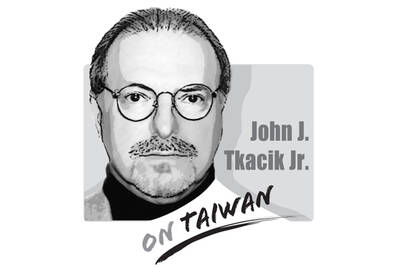Several former directors of the Ma-anshan Nuclear Power Plant in Pingtung County, along with some academics and experts, have launched a petition supporting the extension of the plant’s service life, claiming it has a good safety record. However, the plant has in fact experienced numerous incidents during its 40 years of operation.
On July 7, 1985, less than a year after its No. 1 reactor began commercial operations, a flawed turbine design caused severe vibrations, leading to blade detachment and a hydrogen explosion that sparked a major fire that resulted in a shutdown that lasted one year and two months.
In April 1993, a filter cover in the No. 1 reactor detached due to aging latches, clogged filters, water hammer vibrations and poor design, resulting in 18,927 liters of radioactive wastewater leaking into the South Bay.
In September 1997, a pressure relief diaphragm in the radioactive waste liquid treatment system ruptured, releasing untreated radioactive vapor that deposited on the roof and later washed into rainwater drainage channels.
Between 1994 and 2001, radioactive nuclides were repeatedly detected in drainage ditches near the waste treatment facility.
On March 18, 2001, salt-bearing seasonal sea fog led to an insulator flashover at the plant, causing a ground fault to trip incoming power transmission lines that led to a blackout lasting 2 hours, 8 minutes. The circuit breaker’s insulation failure triggered an electrical fire. Fortunately, the No. 1 reactor was in a low-risk “shutdown” state, averting a nuclear disaster.
The incident was the most severe blackout at a Western light-water reactor at the time, drawing worldwide attention. Taiwan was invited to a regulatory meeting of the Organisation for Economic Co-operation and Development’s Nuclear Energy Agency, where the incident topped the agenda.
The Institute of Nuclear Energy Research said the probability of a core meltdown in the No. 1 reactor during the event was nearly 40 times higher than normal. Salt-bearing sea fog is a natural phenomenon that is difficult to prevent.
On June 12, 2009, a corroded internal insulation layer in a transformer resulted in a fire. Three prior alarms were ignored, leading to a reprimand from the Control Yuan.
On April 26, 2015, an aging ceramic sleeve in the No. 2 reactor’s auxiliary transformer short-circuited a ground fault and caused a fire.
The incidents highlight recurring equipment failures due to aging, which would likely worsen with an extension, increasing risks at the plant.
The plant had also long been incinerating low-level radioactive waste at its on-site reduction center. Radioactive substances, such as strontium-90 and cesium-137, had been detected, posing health risks to the public. Control Yuan members Tien Chiu-chin (田秋堇) and Jao Yung-ching (趙永清) called for a review.
Extending the plant’s operation would prolong public exposure to such risks.
During the major maintenance, various mishaps have occurred at the plant, including stuck hex bolts, bolt fractures, a bolt and disc ejecting and injuring a contractor, a bent control rod drive shaft, fuel rod fractures, and foreign objects, such as lampshades, glass thermometers and bolts, falling into the reactor.
Such incidents are just the tip of the iceberg. The plant’s checkered history makes it unworthy of risking lives to extend its service life.
Tsai Ya-ying is an attorney for the Wild at Heart Legal Defense Association.
Translated by Fion Khan
Chinese agents often target Taiwanese officials who are motivated by financial gain rather than ideology, while people who are found guilty of spying face lenient punishments in Taiwan, a researcher said on Tuesday. While the law says that foreign agents can be sentenced to death, people who are convicted of spying for Beijing often serve less than nine months in prison because Taiwan does not formally recognize China as a foreign nation, Institute for National Defense and Security Research fellow Su Tzu-yun (蘇紫雲) said. Many officials and military personnel sell information to China believing it to be of little value, unaware that
Before 1945, the most widely spoken language in Taiwan was Tai-gi (also known as Taiwanese, Taiwanese Hokkien or Hoklo). However, due to almost a century of language repression policies, many Taiwanese believe that Tai-gi is at risk of disappearing. To understand this crisis, I interviewed academics and activists about Taiwan’s history of language repression, the major challenges of revitalizing Tai-gi and their policy recommendations. Although Taiwanese were pressured to speak Japanese when Taiwan became a Japanese colony in 1895, most managed to keep their heritage languages alive in their homes. However, starting in 1949, when the Chinese Nationalist Party (KMT) enacted martial law

“Si ambulat loquitur tetrissitatque sicut anas, anas est” is, in customary international law, the three-part test of anatine ambulation, articulation and tetrissitation. And it is essential to Taiwan’s existence. Apocryphally, it can be traced as far back as Suetonius (蘇埃托尼烏斯) in late first-century Rome. Alas, Suetonius was only talking about ducks (anas). But this self-evident principle was codified as a four-part test at the Montevideo Convention in 1934, to which the United States is a party. Article One: “The state as a person of international law should possess the following qualifications: a) a permanent population; b) a defined territory; c) government;
The central bank and the US Department of the Treasury on Friday issued a joint statement that both sides agreed to avoid currency manipulation and the use of exchange rates to gain a competitive advantage, and would only intervene in foreign-exchange markets to combat excess volatility and disorderly movements. The central bank also agreed to disclose its foreign-exchange intervention amounts quarterly rather than every six months, starting from next month. It emphasized that the joint statement is unrelated to tariff negotiations between Taipei and Washington, and that the US never requested the appreciation of the New Taiwan dollar during the